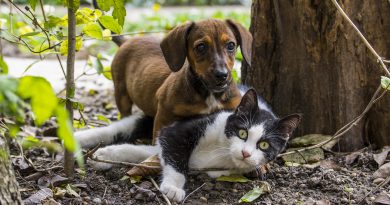Skin Cancer in Dogs and Cats

By now, we all know that we should wear sunscreen year-round to protect ourselves from skin cancer. But did you know that pets are at risk of sunburn and skin cancer, too?
Learn more about pet skin cancer and sunburn and what you can do to protect your pet.
Pet Sunburn
A dog or cat can get sunburn on exposed, sun-sensitive areas. It’s best to avoid much sun exposure between 10 am-4 pm. If your pet will be spending much time in the sun during peak sun hours, apply a pet-safe sunscreen to sun-sensitive areas of the body (nose, tips of the ears, lips, belly, and groin). Pets with light skin and light fur or no hair at all are most at risk of sunburn. Reapply sunscreen just as you would for yourself or a child if your dog swims.
Purchase a pet-friendly sunscreen. Sometimes sunscreen for babies can be used on dogs, but be sure that it doesn’t contain fragrance, PABA (para-aminobenzoic acid) or zinc oxide. The last two are toxic if licked or ingested.
Cats can get sunburn too. There are few cat-friendly sunscreens on the market. If you choose a baby sunscreen, ensure that it doesn’t contain octyl salicylate and similar products which are toxic to cats.
With any sunscreen, watch your pet for the first couple of minutes to prevent licking until the sunscreen has had a chance to soak in. Alternatively, you can choose shirts, hats or goggles to help reduce sun exposure.
Types Of Pet Skin Cancer
Pets can develop several types of skin cancer growths, especially as they age. Sun exposure is a risk factor but it isn’t the only cause of skin cancer. Most growths, lumps, and bumps may be nothing to worry about but should have your veterinarian examine them.
The more common types of skin cancer include:
- Malignant melanoma — Melanomas can either be benign or cancerous. Most often seen on the lips, mouth, and nail bed, melanoma appears as raised, ulcerated bumps.
- Mast cell tumors — The most common type of cancer in dogs, mast cell tumors grow anywhere on the body and release histamine that causes an allergic reaction.
- Histiocytic cell tumors — This is a type of cell that proliferates and grows into tumors. Younger dogs and Scottish Terriers, Bulldogs, Greyhounds, Boxers, Boston Terriers, and Chinese Shar-Pei are at a higher risk.
- Fibrosarcoma — Fibrosarcoma is found in the connective tissues beneath the skin. They grow slowly and rarely metastasize.
- Squamous Cell Carcinoma — This is the most common type of carcinoma and typically shows up on lower legs, abdomen, head, and rear. Carcinoma appears as lumps that are firm to the touch. They can appear as sores or ulcers on cats.
Risk Factors For Pet Skin Cancer
The exact cause of skin cancer is unknown, and each type of cancer develops differently. There are several factors that can predispose your pet to skin cancer.
- Age (pets over the age of 7)
- Hormonal dysfunction
- Breed, including Basset Hounds, Beagles, Cairn Terriers, Miniature Poodles, Cocker Spaniels, Dachshunds, Samoyeds, Shih Tzus, Huskies, and West Highland White Terriers.
- Sun exposure plays a role in certain skin cancers, especially if your pet has light skin and fur.
- Indoor pets (especially hairless breeds) can be at risk of skin cancer if they are in the above-mentioned categories. Indoor cats who sunbathe in rays coming through the windows are soaking up UVA and UVB rays.
- For cats, high altitude is also a risk factor for squamous cell carcinomas.
Diagnosis And Treatment Of Pet Skin Cancer
Diagnosing skin cancer is done by examining the skin cells of the tumor or lesion. Treatment can involve surgery, radiation, chemotherapy, and immunotherapy, depending on the type of cancer. Early detection is key to a good prognosis, so follow up with any unusual lumps or wounds on your pet’s body.
Preventing Pet Skin Cancer
You can’t prevent all cancers, but you can be proactive about your pet’s health.
- Maintain your pet’s annual wellness examination
- Limit sun exposure and apply a pet-friendly sunscreen to areas of exposed skin like the abdomen and nose.
- Give your pet a routine “once-over” every few weeks to check the skin and overall body condition.
The most important thing you as a pet owner can do is to follow up with your veterinarian if something seems odd. Paying close attention to your pet’s health can go a long way to early detection and recovery.













